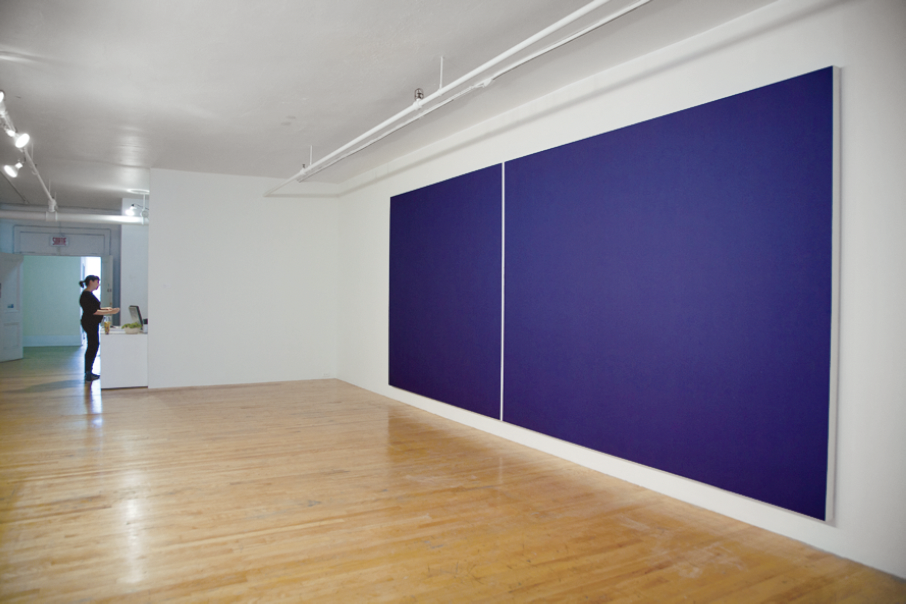Alana Riley
Irreverence is the name of Alana Riley’s game, exhibited here with a big helping of conceptual acuity, a heaping side order of mischief and dollops of pure glee. Her exhibition “You Are The Work, 2011” brings the monochrome to its knees and delivers it from the past-tense of Modernism to the present tense of conceptual art. Notably, her photo/video works are rife with knowing references to art history, citing works by Barnett Newman (and, by extension, Canada’s Claude Tousignant) and John Baldessari. In any case, she produces photographic and video work that redeems the monochrome from the optical discourse around Modernist painting.
Apparently, her ping-pong table/work desk with its vast blue expanse and white dividing line triggered in her mind a memory of Barnett Newman’s painting Cathedra, 1951. So she created a simulacrum of the Newman painting in an enlarged photograph of her ping-pong table. The photograph of herself with an unidentified male standing alongside her in front of a vast blue field (albeit one infected with sundry dust motes) serves as a potent reminder that, in the experience of monochrome painting, the observer is always the ultimate reference pole. The dust “hiccups” register a lovely impurity against the work’s formal purity.
There is a related video, where you hear a ball hitting the table, as though the retina were bouncing off the blue field like a ping-pong ball, relentlessly reorienting itself all the while. Playing off not only the mimetic experience of Newman’s painting and the ping-pong table, Riley dips into synaesthesia.

Alana Riley, Kettler’s Cathedra, 2011, installation view of “You Are The Work,” Joyce Yahouda Gallery, Montreal, digital print on canvas, 239 cm x 553.8 cm. Photograph: the artist.
Newman’s stellar 1951 painting Cathedra, in the Stedelijk Museum in Amsterdam (where it was vandalized by the knife-wielding assailant Gerard Jan van Bladeren in 1997), induces reflections of a very eclectic order indeed: a midnight-blue sky, the music of Miles Davis, theological speculations, the threshold of the ocean, and even melancholy of a most erotic persuasion. Riley’s eloquent, conceptual inversion reveals not only the painting but also Gerard Jan van Bladeren who shoved a shiv knife into its heart.
Riley’s exhibition is not only about crying the blues but also calls to mind William Gass’s On Being Blue: A Philosophical Inquiry (D.R. Godine, 1975), that brilliant treatise in which he claimed that of all the colours, blue and green have the greatest emotional range. For dyed-in-the-wool lovers of the monochrome, Riley’s smart take possesses both poetry and perceptual panache. Gass argued that Christ and the Virgin wore mantles of blue because as the clouds retire from the sky the Truth appears. This may or may not be true, but it is certainly blue, and resonant of what Riley attempts—and achieves.
Medievalist Michel Pastoureau, in his history of this colour, held that it was once considered a hot colour, but is now perceived as icy cool. I think that’s true. Perhaps as a reaction against an earlier chromophobia, new shades were created and blue became the colour of romance. Now it is the universal and unifying colour of Gaia herself as seen from outer space.

Alana Riley, You Are The Work (Asking Strangers to Sit Through John Baldessari’s “Six Colorful Inside Jobs”), 2011, video still, colour video, sound, 32 minutes. Images courtesy the artist and Joyce Yahouda Gallery, Montréal.
Another of Riley’s telling references to art history is the proximate You Are the Work (Asking Strangers to Sit Through John Baldessari’s “Six Colorful Inside Jobs”), 2011, which is radical, instructive—and audacious. In this work we watch a video of people—randomly picked, mostly aspiring actors and performers—whom Riley asked to be spectators. This audience reacts to Baldessari’s piece with intense concentration (alleviated by the odd sneeze, shuffle and sideways glance). Baldessari had filmed a small room being painted in a new and different colour six days of the week, with primary colours alternating with secondaries. The colours he used are reflected on the faces of Riley’s audience: red for Monday, orange for Tuesday, yellow for Wednesday, green for Thursday, blue for Friday and violet for Saturday. In showing us the audience rather than the movie, Riley shifts the perspective to that of the spectator of monochrome painting rather than the object itself. But then, the claim of monochrome painting is that the observer is the ultimate reference pole. We are responsible; reception is everything. So, too, in Riley’s work, where she plays up our responsibility for just what it is we are seeing, where our complicity in the making of meaning—perceptual and phenomenological—becomes absolute. She shines a welcome light on her observers, for after all, and unavoidably, we are the work. ❚
“You Are The Work” was exhibited at Galerie Joyce Yahouda, Montreal from September 8 to October 22, 2011.
James D. Campbell is a writer and curator living in Montreal who contributes regularly to Border Crossings._

